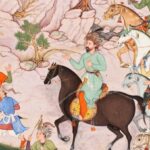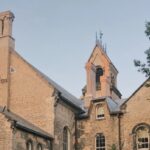Native Spaces: Tracing the History of California Indians and Sacred Land
Damon B. Akins and William J. Bauer Jr. on the Huchiun Ohlone People of the East Bay
In early October of 2015, Bancroft Way, by way of Boalt Hall’s courtyard on the University of California, Berkeley, campus, offered a spectacular view. Most people did not seem to notice, likely because the view is so often stunning and easy to take for granted. One saw San Francisco Bay three miles and 300 feet down the hill. Across the bay, the towers of the Golden Gate Bridge and the Marin Headlands rose above the fog. People gathered at Boalt Hall for the 30th meeting of the California Indian Conference. Conference attendees radiated a triumphant mood. Panel sessions and addresses began with greetings and recognitions in Chochenyo, the language spoken by the Huchiun Ohlone people of the East Bay.
For thousands of years, the Huchiun Ohlone took in similar views as they moved seasonally from permanent village sites along the shore of San Francisco Bay at Temescal Creek and Strawberry Creek, inland to meadows and oak groves in the hills. Now, Ohlone students, scholars, elders, and other native Californians moved from lectures, panel discussions, and keynote addresses in the law school and the University Club on top of the newly remodeled Memorial Stadium. The Elder’s Hospitality Room, in the Chancellor’s Box, provided tribal elders and special guests with refreshments and a place to rest and take in the panoramic views of Oakland and San Francisco. Luiseño-Cahuilla Edward Castillo led an excursion to Alcatraz Island. Puyukitchum-Ipai-Mexican American James Luna performed his piece “Native Stories.” Graton Rancheria Greg Sarris and Ohlone-Costanoan Esselen Nation Deborah Miranda delivered keynote addresses. The meeting felt like a reoccupation.
For thousands of years, the Bay Area was one of the most densely populated regions on the West Coast. The People who lived there were the children of Coyote, who lived at Reed’s Peak, and Eagle, who lived on Mount Diablo. Both possessed a view of the Bay Area similar to the one down Bancroft Way. After a great flood receded, Coyote and Eagle placed their children on the shores of the bay.
At the time of European contact, at least 50,000 people lived from the Carmel River to the San Francisco and San Pablo Bay area. They consisted of 50 or so small bands, who spoke at least eight mutually intelligible languages. There was more water then, and the Ohlone elevated their 30 to 40 permanent villages above the marshland on shell mounds—huge piles of shells, earth, and ashes. Today, a memorial at the Bay Street Shopping Mall at the corner of Shellmound Street and Ohlone Way marks the Emeryville Shellmound, located where Temescal Creek empties into the bay. The West Berkeley Shellmound stretches a few blocks inland from where Strawberry Creek empties into the bay at the Berkeley Marina.
Beginning in 1776, Franciscans established a total of six missions in Ohlone territory, the first of which they named Mission San Francisco de Assisi (Mission Dolores) in San Francisco. Most Chochenyo speakers went to Dolores, and then San José, following its 1796 founding. After secularization, Mexican officials recognized Luis Maria Peralta’s Rancho San Antonio land grant, which comprised more than 44,000 acres in what is now San Leandro, Oakland, Alameda, Emeryville, Piedmont, Berkeley, and Albany. Ohlones worked on the rancho, herding the 8,000 cattle grazing on their lands and butchering the animals for the hide and tallow trade.
Spared the worst of the genocidal violence that decimated Indigenous People in other parts of Northern California, Ohlones faced erasure during the Gold Rush. In 1850, federal subagent Adam Johnston reported, “Of the numerous tribes which but a few years ago inhabited the country bordering on the bay of San Francisco, scarcely an individual is left.” During the American period, affiliated Ohlone reoccupied old places. Ohlones reestablished a community at Alisal, in Pleasanton.
The museum acquired many others from hobbyists and amateurs whose work can only accurately be labeled grave robbing.Initially part of the Rancho Valle de San José land grant, in the late 19th century Phoebe Apperson Hearst, wife of mining magnate and US senator George Hearst, purchased the land. Hearst sympathized with Ohlones and allowed them to live and work at Alisal. Americans named the rancheria the Verona Station Community. Ohlones integrated the Ghost Dance and the World Renewal Ceremony with local dances and ceremonies. They remained connected to other nearby sites at Niles and Sunol.
In 1906, Charles Kelsey, a lawyer from San Jose working with the Northern California Indian Association, conducted a survey of Northern California Indians and recorded the community as the Verona Band of Indians of Alameda County. He recommended the federal government buy land for them. The government did not. In 1919, Phoebe Hearst died, and the new owners evicted the residents of Alisal because they had no title to the land. Eventually, the property became the Castlewood Country Club.
Elsewhere in the East Bay, another group of settlers erased Ohlones. In 1873, the state moved the University of California to a site along Strawberry Creek, in Berkeley. The Hearst family donated a considerable amount of money to the university, a legacy that lives on in numerous buildings and structures bearing the family name. In 1901, Hearst founded the University of California Museum of Anthropology in the Parnassus Heights neighborhood in San Francisco to house Phoebe’s extensive collection of Indigenous artifacts. The triangular relationship between philanthropists, academics, and California Indians built the museum and the university’s academic reputation. The university established the first Linguistics Department in the nation. Some of the biggest names in the field, who worked closely with ethnologists like John Peabody Harrington from the Smithsonian, staffed its Anthropology Department.
In 1925, Alfred Kroeber, the head of the department, declared the Verona Band extinct in his Handbook of the Indians of California. At the same time, Harrington recorded languages with Chochenyo speakers Angela (María de los Angeles) Colós and José Guzman. Today, Harrington’s extensive collection of field notes on California Indian languages is vital to those trying to reconstruct these dormant languages. Kroeber later acknowledged his mistake but only after the superintendent in a regional Bureau of Indian Affairs office removed the tribe from the list of federally recognized tribes in 1927. In the 1930s, lack of official recognition removed the Verona Band from the Indian Reorganization Act process, which, while problematic, created ways for tribes to create tribal governments and acquired loans available for tribes to purchase land.
In 1931, the university’s museum relocated to the Berkeley campus. In 1991, the university renamed the museum the Phoebe A. Hearst Museum, which contains the second-largest collection of California Indian artifacts after the Smithsonian. The museum holds 10,000 ancestral remains, many excavated from the region’s shell mounds, villages, and burial sites. Archaeologists exhumed some of the remains under the direction of Kroeber and other anthropologists at the university. The museum acquired many others from hobbyists and amateurs whose work can only accurately be labeled grave robbing.
The Second World War transformed the Bay Area yet again. The population grew dramatically, land prices soared, and the freeway system was grafted onto the land. In the early 1960s, the Oakland diocese of the Catholic Church sold a portion of Mission San José’s cemetery, where many Ohlone ancestors are buried, to housing and retail developers. In 1964, the proposed route of Interstate 680 threatened to destroy the rest of the cemetery. Ohlone Dolores Marine Galvan pressured CALTRANS to change the route. Philip Galvan, Dolores’s son and secretary for the San Francisco–based American Indian Historical Society (AIHS), launched a crusade to save the cemetery. In 1971, Cahuilla Rupert Costo and Cherokee Jeannette Henry Costo, founders of the AIHS, brokered a deal with the diocese to transfer ownership to the AIHS, who in turn, deeded the land to a new entity: the Ohlone Indian Tribe Inc.
Cultural revival occurred all around the region. In 1969, the first Native American Studies program in the United States was founded at San Francisco State University. This and other newly established regional Native American Studies programs helped forge tentative and complicated alliances among academics, activists, tribal members, the counterculture, and the educational institutions where these groups increasingly met.
The annual California Indian Conference wove these two threads together and quickly became a vital part of California Indian life.In 1985, Native students and activists worked with the Anthropology Department, the Native American Studies Program, the Linguistics Department, and the Lowie Museum of Anthropology at UC Berkeley to organize the first California Indian Conference. The conference sought to provide an opportunity for scholars working on California Indian topics to share their research. A mixture of academics and public officials from colleges and universities, museums, and public history sites across the nation presented brief talks.
While a few California Indians gave presentations at the conference, their presence was primarily as subjects of study. That changed the following summer, when the Lowie Museum sponsored a conference called “Weaving Ancient Traditions into the Fabric of Modern Indian Life” on campus. Conference organizers wanted to bring California Indian artists to campus to meet with educators and scholars. By the end of the decade, the annual California Indian Conference wove these two threads together and quickly became a vital part of California Indian life.
Ohlones, too, revitalized culture and politics. Vincent Medina, who later opened Café Ohlone in Berkeley with Louis Trevino, acquired a copy of the Chochenyo dictionary. Working with that and the Harrington recordings, he began to piece together the dormant language, eventually studying linguistics at UC Berkeley. Medina helped to revive the language and eventually worked alongside his cousin, Andrew Galvan, as the assistant curator at the Mission San Francisco, the site of his six-time great grandfather’s baptism.
At Mission San Francisco, Medina speaks the Chochenyo language to visiting school children, who are often surprised to learn Ohlones still exist. Galvan and Medina publicly disagreed when, in 2015, the Catholic Church sought to canonize Junípero Serra, a process that began in 1985, when the pope declared him “Venerable.” Galvan, an outspoken supporter of the effort, praised it. Medina, an equally vocal critic, claimed canonizing “the leader of the disastrous, genocidal California mission system is a way that the church further legitimizes the pain and suffering of Ohlone and countless other California Indians.” Outsiders often describe disagreements within Indigenous communities as “factionalism” and proof of Indigenous political impotence. Instead, Medina and Galvan approached sovereignty and cultural preservation from different vantages. They agreed on the end result although they might not walk the same path to get there.
The same held true for land. The parking lot across from Spenger’s Fish Grotto restaurant on Fourth Street in Berkeley is the last portion of the West Berkeley Shellmound that remains relatively undeveloped. It is also immediately adjacent to the Fourth Street Shops, and a coveted spot for developers. Plans for the construction of a five-story mixed-use residential and retail development on the site emerged in 2015. Fierce opposition by some members of the local Ohlone greeted the announcement. Chochenyo Ohlone Corrina Gould, of Indian People Organizing for Change, argued, “When it comes to sacred sites, we as a society should think about things in a different way. This was the very first place inhabited on the entire bay—that is something that should be worth saving.”
Vincent Medina pointed out, “We did not stand in opposition when you developed other parts of our land. We do not get in the way when you put up apartment buildings or shopping malls. But where we draw the line is when you propose to dig up and desecrate the most sacred places where our ancestors are buried.”
Some Ohlone supported the project. Andrew Galvan consulted on the project. In late 2018, Spenger’s closed after 128 years. Its closure makes the property even more tempting to developers. In October of 2019, the court ruling on the West Berkeley Shellmound upheld the decision to reject the housing project. The judge wrote that “a historic structure does not cease to be a historic structure” simply because “it is ruined or buried.” That principle, he argued “would exclude many of the world’s most beloved archaeological treasures.” Despite the decision, pressure to develop the area, and the fight against it, continues.
And yet, the East Bay remains a place that Indigenous People and their relations reoccupy. The California Indian Conference has been held at UC Berkeley six times. In 2020, the city of San Francisco and much of the East Bay went into quarantine because of the COVID-19 pandemic. Not long after, people reported seeing Coyote roaming the streets, looking for food and observing how the space changed since he arrived after the flood and bore children with Eagle.
__________________________________

Excerpted from We Are the Land: A History of Native California. Used with the permission of the publisher, University of California Press. Copyright © 2021 by Damon B. Akins and William J. Bauer Jr.




















